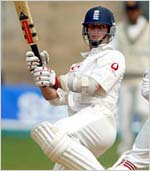 December 31, 2001
December 31, 2001
From an England fan's perspective
- Jonathan Dyson
As I sit here, scribbling away on the idyllic beach of Palolem in South Goa, nestled between glorious, baying palm trees, and the Arabian Sea glistening in the sunlight, the chanting and cheering, tension and excitement, and continuous ebb and flow of the Test matches at Mohali, Ahmedabad and Bangalore seem like they took place in another world.
It is of course testament to the huge diversity in climate, geography, culture and lifestyle to be found within India, that you can find yourself in a place which feels like an age away from where you came, when it is in fact just a short train ride away.
A group of us took the night train from Bangalore and arrived in Goa on Christmas eve. Since then we have been relaxing, wining and dining, playing endless games of beach cricket, and reflecting on what has been a fascinating and eventful series.
Now that I have had some time to look back on the three Tests, I would like to provide here a review of the series from an England fan's perspective. I would also like to respond to some of the issues raised in your e-mails.
Now that the disappointment of the climax, or rather anti-climax, to the Test at Bangalore has begun to disappear, we have realised that the pluses to be taken from the series far outweigh the minuses. And the fact that, despite losing the series, most England fans have a smile on their faces at the moment, indicates not only our pleasure at seeing the team improve so much in India, but also to what extent a fan's life is based around optimism.
After all, thoughts of whether your team are progressing and how they could improve are always at the forefront of any fan's mind. And that is why England fans are so upbeat at the moment.
England have been in similar situations in the past, where there has been a genuine feeling that the team are making progress, and on the verge of becoming a top class side, but this has invariably been followed by another disastrous series, and another set of radical selection changes. Yet now, England's future really does appear brighter than at any point in my memory as an England fan, which goes back twelve years.
 Even the two rookies, Dawson and Foster, came away from India looking like Test players. This is
extremely rare for England. Because of the chasm between county and Test cricket, and the lack of
intensity in school and club cricket, England players almost always need a few years in county cricket
and at least one A tour, until they are ready to enter the Test arena.
Even the two rookies, Dawson and Foster, came away from India looking like Test players. This is
extremely rare for England. Because of the chasm between county and Test cricket, and the lack of
intensity in school and club cricket, England players almost always need a few years in county cricket
and at least one A tour, until they are ready to enter the Test arena.
Whether the success of Dawson and Foster in India is down to either exceptional talent or astute man-management or both is a moot point. What matters is that for the first time in a long time England have two players below the age of twenty-two who look comfortable playing Test cricket.
Add to this the progress made by Butcher, Flintoff, White and Hoggard, the return to form and fitness of Hussain and Giles, and the fact that Thorpe, Stewart, Gough, Caddick and Croft were not involved in the second and third Tests, and you can understand why England fans feel that they can now start to win in places like India, and even challenge South Africa to second place in the Test championship.
As Hussain pointed out at the end of the series, England have quite simply a much bigger squad of Test class players to choose from now.
I was not surprised to receive a handful of e-mails reacting to my expression of support for the tactics employed by England against Tendulkar at Bangalore. I can fully understand your fears about how such an approach could lead to a decline in the quality of Test cricket, and subsequently the size of the crowds.
Yet therein lies the problem. Most of the arguments against the tactics are about what may happen in the future, rather than simply what happened at Bangalore. The fact is that such an approach has been used before, not just in the infamous Bodyline tour, but also more recently, by bowlers such as Heath Streak and Jacques Kallis.
Never has it begun a trend of so-called negative bowling being used regularly. Such tactics are simply an occasional feature of Test cricket, and are used now and again by certain players. They are extremely unlikely to ruin the game for ever.
 Another issue raised from the Banglore Test came with the dismissal of Vaughan for handling the ball. Everyone knows that he was unlucky, and everyone knows that he was correctly given out.
Another issue raised from the Banglore Test came with the dismissal of Vaughan for handling the ball. Everyone knows that he was unlucky, and everyone knows that he was correctly given out.
Yet what Vaughan did was only slightly different to what happens on a regular basis at every level of cricket, where a batsman lobs the ball back to a close fielder to save time. The only difference with Vaughan was that he did so slightly sooner than normal, and with the ball moving slightly more quickly.
The incident showed that the law regarding being given out handled the ball needs to be more specific. Strictly speaking, as the law stands at the moment, if Vaughan had seen the ball trickle slowly in front of him, and waited, say three seconds, before touching it and handing it back to a close fielder, and a member of the fielding side had appealed, he would still have to have been given out.
Surely a batsman should only be dismissed if he handles the ball in order to try and protect his stumps. Vaughan, generally regarded as an honest man, said that he was not trying to do so. Therefore it would surely make sense if umpires were given the power to judge whether the batsman was indeed trying to protect his stumps, rather than simply being forced to give the batsman out if he handles the ball and a member of the fielding side happen to appeal.
GE Features
©1996 to 2001 rediff.com India Limited. All Rights Reserved.